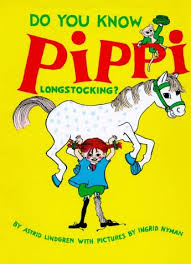Most Beloved Sister
 Allrakaraste Syster was published in 1949 and later translated by Elisabeth Kallick Dyssegaard. It was illustrated by Hans Arnold, which I think is the only Astrid Lindgren book with that illustrator. Hans Arnold did incredible work on this book and really used color and imagination to enhance the story. The details in each picture are overwhelming.
Allrakaraste Syster was published in 1949 and later translated by Elisabeth Kallick Dyssegaard. It was illustrated by Hans Arnold, which I think is the only Astrid Lindgren book with that illustrator. Hans Arnold did incredible work on this book and really used color and imagination to enhance the story. The details in each picture are overwhelming.
It tells the story of Barbara, whose twin sister Lalla-Lee is a queen in a secret land. Together they journey through the Great Horrible Forest and the Most Beautiful Valley in the World.
This is very difficult book to find: my library system has only one copy, but I could not get it for months because it kept being checked out even though I had placed a hold on it. Finally, Peter came to the rescue and found a copy for me through the university. Copies of this book are for sale for well over $50. I think it’s time this book was re-printed!
This is a short but charming story with a poignant ending that will help children who feel alone. It teaches children about imagination, friendship, and life cycles.
This scene is beautiful and terrible at the same time: Then Lalla-Lee grabbed my arm very tightly and said, “Most Beloved Sister, there is something you must know!”
Right then, I felt a pain in my heart.
“No,” I said, “I do not want to know.”
“Yes, there’s something you must know,” Lalla-Lee went on. Then the flowers stopped singing and the trees stopped playing, and I could no longer hear the brook’s melody.

 grown-ups aren’t looking. Everyone is happy, the end.
grown-ups aren’t looking. Everyone is happy, the end. Do You Know Pippi Longstocking? is a book I almost didn’t include in the all-Astrid read of 2015. Of course it’s by Astrid Lindgren, but it’s a retelling of previous Pippi stories (translation by Elisabeth Kallick Dyssegaard). There’s really no new material here. But . . . it was published in 1947 under Kanner du Pippi Langstrump? and it’s a quick read, plus it’s listed on Astrid’s website, so whatever, here it is:
Do You Know Pippi Longstocking? is a book I almost didn’t include in the all-Astrid read of 2015. Of course it’s by Astrid Lindgren, but it’s a retelling of previous Pippi stories (translation by Elisabeth Kallick Dyssegaard). There’s really no new material here. But . . . it was published in 1947 under Kanner du Pippi Langstrump? and it’s a quick read, plus it’s listed on Astrid’s website, so whatever, here it is: